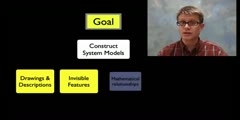Lec 12 - Overlapping Generations Models of the Economy
"Lec 12 - Overlapping Generations Models of the Economy" Financial Theory (ECON 251) In order for Social Security to work, people have to believe there's some possibility that the world will last forever, so that each old generation will have a young generation to support it. The overlapping generations model, invented by Allais and Samuelson but here augmented with land, represents such a situation. Financial equilibrium can again be reduced to general equilibrium. At first glance it would seem that the model requires a solution of an infinite number of supply equals demand equations, one for each time period. But by assuming stationarity, the whole analysis can be reduced to one equation. In this mathematical framework we reach an even more precise and subtle understanding of Social Security and the real rate of interest. We find that Social Security likely increases the real rate of interest. The presence of land, an infinitely lived asset that pays a perpetual dividend, forces the real rate of interest to be positive, exposing the flaw in Samuelson's contention that Social Security is a giant, yet beneficial, Ponzi scheme where each generation can win by perpetually deferring a growing cost. 00:00 - Chapter 1. Introduction to the Overlapping Generation Model 12:59 - Chapter 2. Financial and General Equilibrium in Social Security 26:37 - Chapter 3. Present Value Analysis of Social Security 59:24 - Chapter 4. Real Rate of Interest and Social Security Complete course materials are available at the Open Yale Courses website: http://open.yale.edu/courses This course was recorded in Fall 2009.
Video is embedded from external source so embedding is not available.
Video is embedded from external source so download is not available.
Channels: Finance
Tags: Lec 12 - Overlapping Generations Models of the Economy
Uploaded by: yalefinancialth ( Send Message ) on 12-09-2012.
Duration: 72m 34s
Here is the next lecture for this course
Mitosis Models
02:53 | 10712 viewsLec 173 - Moderate Inflation in a Good Ec ...
02:55 | 2712 viewsLec 47 - Laboratory Procedures for Maste ...
38:01 | 5478 viewsLec 56 - Pouring Models and Trimming Fina ...
07:13 | 9617 viewsLec 20 - Economics 119 - Lecture 24: Boun ...
01:18:49 | 2422 viewsLec 12 - Edible Education: Place Based Mo ...
01:06:00 | 3077 viewsUsing Different Models
08:22 | 2328 viewsIntroduction With Systems and System Models
08:05 | 2028 viewsWatson constructing base pair models
01:43 | 8005 viewsLec 107 - SMOG OR JOBS? The Impact of Tig ...
01:07:45 | 3480 viewsLec 53 - Renewable Energy and the Economy
59:35 | 4310 viewsLec 62 - The Real Story on Fuel Economy
01:01:26 | 3178 viewsLec 12 - Effective Models for Sustainable ...
55:20 | 6646 viewsLec 9 - Case Discussion and Business Models
16:51 | 3056 viewsLec 25 - Models in 3D Space (1869-1877); ...
49:02 | 3426 viewsNo content is added to this lecture.
This video is a part of a lecture series from of Yale
Lecture list for this course
Lec 2- Utilities, Endowments, and Equilibrium
Lec 4- Efficiency, Assets, and Time
Lec 5- Present Value Prices and the Real Rate of Interest
Lec 6 - Irving Fisher's Impatience Theory of Interest
Lec 7 - Shakespeare's Merchant of Venice and Collateral, Present Value and the Vocabulary of Finance
Lec 8 - How a Long-Lived Institution Figures an Annual Budget. Yield
Lec 10 - Dynamic Present Value
Lec 13 - Demography and Asset Pricing: Will the Stock Market Decline when the Baby Boomers Retire?
Lec 14 - Quantifying Uncertainty and Risk
Lec 15 - Uncertainty and the Rational Expectations Hypothesis
Lec 16 - Backward Induction and Optimal Stopping Times
Lec 17 - Callable Bonds and the Mortgage Prepayment Option
Lec 18 - Modeling Mortgage Prepayments and Valuing Mortgages
Lec 19 - History of the Mortgage Market: A Personal Narrative
Lec 21 - Dynamic Hedging and Average Life
Lec 22 - Risk Aversion and the Capital Asset Pricing Theorem
Lec 23 - The Mutual Fund Theorem and Covariance Pricing Theorems
Lec 24 - Risk, Return, and Social Security
Lec 25 - The Leverage Cycle and the Subprime Mortgage Crisis
















